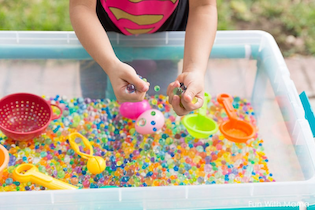Sensory bins … What are they? Why do we use them for therapy?
Sensory bins are fun (and functional) therapy tools! They provide the opportunity to experience different textures during play and for some kids, it can help increase their tolerance of different textures to help with tactile sensitivities. Using different textures in sensory bins can help children explore what something new feels like. Different kids prefer different textures based on their tactile preferences (We recommend letting your child feel the texture first on a smaller scale in order to find the right fit of what to use when making your sensory bin!)
Below, an Emerge OT and SLP have created a list of different textures you can try at home along with some tips and tricks for expanding play with sensory bins!
Recommendations for textures:
- If eating the items isn’t a concern, general textures you can use
- Dry
- Rice
- Sand (dry and kinetic)
- Beans
- Lentils
- Orbeez
- Dried pasta
- Water
- Foam soap/shaving cream
- For children at risk of eating items in the bin
- Rolled oats
- Ground up graham crackers
- Cooked rice or spaghetti
- Mardi gras beads
- Digging in Jello

Dried Bean Sensory Bin

Sand Sensory Bin

Jello Sensory Bin

Orbeez Sensory Bin

Oat Sensory Bin
How to set up your sensory bin:
- Set up the sensory bin in a small or large container or box!
- Set-up the bin on a blanket or towel for easy clean-up
- Use outside to avoid clean up inside
- Limit number of children aloud to play at one time
- Use under adult supervision!
- When sensory play is done, put the contents in a Ziploc bag for easy storage
Recommendations for expanding play with bins:
- Hide objects in the sensory bin to assist with modeling language concepts. This could be different colors, shapes, or animals. Also can be motivating for longer engagement to use preferred toys that will capture their interest or to have to find pieces of something to complete, like a puzzle.
- Add letters or numbers — can use with more challenging academic tasks
- Turn-taking — take turns hiding and searching for items
- Include items that may assist with the fine-motor skills or learning to use utensils or manipulate containers, such as spoons, plastic eggs, or small tupperware containers with lids
- Include cookie cutters or plastic tools to experiment with making different designs and using tools of different functions (i.e. rolling, hammer, etc.)
- Use construction vehicles for added fun

0 Comments